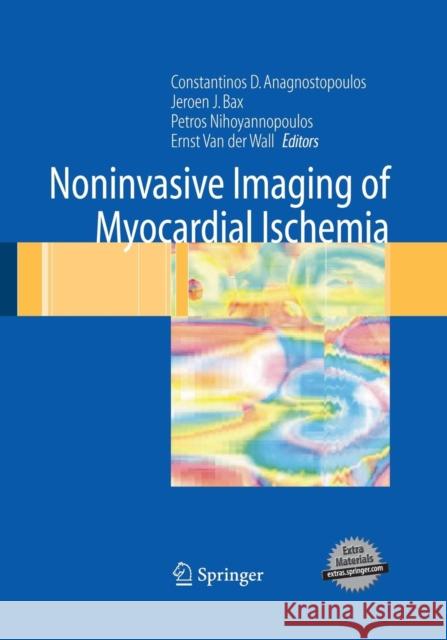Noninvasive Imaging of Myocardial Ischemia » książka



Noninvasive Imaging of Myocardial Ischemia
ISBN-13: 9781447171218 / Angielski / Miękka / 2016 / 319 str.
Noninvasive Imaging of Myocardial Ischemia
ISBN-13: 9781447171218 / Angielski / Miękka / 2016 / 319 str.
(netto: 421,70 VAT: 5%)
Najniższa cena z 30 dni: 424,07
ok. 22 dni roboczych
Dostawa w 2026 r.
Darmowa dostawa!
From the reviews:
Doody's Rating: 3 stars
Reviewer: Seth Jay Kligerman, MD, MS(University of Colorado School of Medicine)
Description: This book describes in detail the various imaging modalities used to evaluate myocardial ischemia. Additionally, the pathophysiology of myocardial ischemia is discussed in detail.
Purpose: The purpose of the book, according to the author, is to discuss the pathophysiology of myocardial ischemia as well as the various radiologic modalities used in its evaluation. These are worthy objectives, given the recent advances in the field over the past few years. The author meets his objectives.
Audience: According to the author, the book is written for any practitioner interested in noninvasive imaging of cardiac ischemia. I believe the book is intended primarily for nonradiologists interested in cardiac imaging. The authors are credible authorities.
Features: The first part of the book covers basic cardiac anatomy and physiology and the pathophysiology of myocardial ischemia. The second part covers the various imaging modalities (echocardiography, radionuclide imaging, CT, and MRI) used in the evaluation of myocardial ischemia. As a radiologist, I enjoyed the detailed discussion on the pathophysiology of myocardial ischemia. However, the book is limited in its discussion of MRI pulse sequences used in cardiac MR.
Assessment: Overall, this is an excellent book that provides a detailed look at the use of different radiologic imaging studies in the evaluation of myocardial ischemia. Additionally, the discussion on the pathophysiology of myocardial ischemia is a nice addition for radiologists and nonradiologists.
Score: Weighted Numerical Score: 84
"Noninvasive Imaging of Myocardial Ischemia is a concise review of current multimodality imaging techniques used for the evaluation of ischemic heart disease. The intended audience includes physicians and trainees involved in cardiac imaging, particularly radiologists, nuclear medicine physicians, and cardiologists. ... the book successfully gathers together a large amount of cardiac imaging research, digests it, and provides the reader with a concise picture of current utilization and future trends. I would recommend ... as a useful guide to the present status of the field." (Paul R. Jolles, Radiology, Vol. 244 (3), 2007)
Principles of Pathophysiology Related to Non-Invasive Cardiac Imaging.-Echocardiography in Coronary Artery Disease.-Cardiac Magnetic Resonance (CMR).- Myocardial Perfusion Scintigraphy.-Positron Emission Tomography (PET).-Computed Tomography-Techniques and Principles: Part 1. Electron Beam Computed Tomography.-Computed Tomography-Techniques and Principles: Part 2. Multi-Slice Computed Tomography.-The Non-Invasive Assessment of Asymptomatic Individuals at Risk of Coronary Heart Disease: Part 1.-Non-Invasive Assessment of Asymptomatic Individuals at Risk of Coronary Heart Disease: Part 2.-Diagnosis of Coronary Artery Disease.-Prognostic Assessment by Non-Invasive Imaging. Part 1. Clinical Decision Making in Patients with Suspected or Known CAD.-Prognostic Assessment by Non-Invasive Imaging. Part 2. Risk Assessment before Non Cardiac Surgery by Non-Invasive Imaging.-Imaging in the Emergency Department or Chest Pain Unit.-Risk Stratification after Acute Coronary Syndromes.-Role of Stress Imaging Techniques in Evaluation of Patients before and after Myocardial Revascularization.-Imaging Techniques for Assessment of Viability and Hibernation.-Myocardial Ischemia in Conditions other than Atheromatous CAD.- Myocardial Ischemia in Congenital Heart Disease - The role of Non-Invasive Imaging.
Dr C. D. Anagnostopoulos is working at the Royal Brompton Hospital, he is an ex-president of the British Nuclear Cardiology Society and Guest Editor to the HEART journal. Dr Nihoyannopoulos is Secretary of the European Working Group on Echocardiography and Deputy Editor of the Eur J Echocardiography. He is currently the head of the Echocardiography laboratories at Hammersmith Hospital. Professor Jeroen Bax (Leiden University Medical Center, Leiden, Netherlands). Professor Ernst Van der Wall (Leiden University Medical Center, Leiden, Netherlands) is an extremely influential name in cardiac imaging. He has written or edited numerous cardiac imaging books and is one of the most respected names in the field.
Non-invasive imaging plays a very important role in the assessment of patients investigated for coronary artery disease, providing valuable information for diagnosis and aiding management decisions. It covers a broad spectrum of investigations including radionuclide imaging, echocardiography, magnetic resonance imaging and computed tomography.
Progress towards the most efficacious means of assessing a patient is relentless, with recent years seeing an important shift in emphasis from invasive to noninvasive techniques. This informative book compares the various modalities in a practical diagnostic environment. It thus provides a forum for fertile discussion, bringing the discussion of these various methodologies together in one reference for the first time. The narrative flow is unique and will ensure that all levels of medical practitioners with an interest in cardiac imaging will find this an unparalleled resource for use in guiding their practice.
1997-2025 DolnySlask.com Agencja Internetowa
KrainaKsiazek.PL - Księgarnia Internetowa









